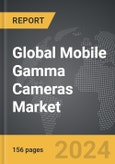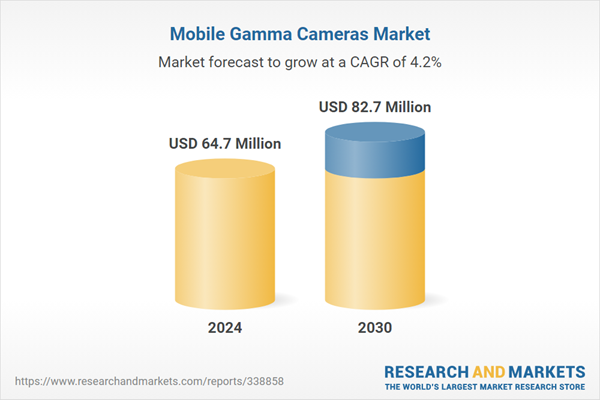Mobile Gamma Cameras - Key Trends and Drivers
A gamma camera, also known as a scintillation camera, is pivotal for imaging gamma radiation-emitting radioisotopes. This technique, scintigraphy, is essential in nuclear medical imaging and drug development. It helps visualize radionuclide distribution in the body, enhancing diagnosis and treatment. Mobile gamma cameras facilitate bedside diagnostics, offering convenience and improved patient care. Their portability allows for use in remote locations, vital for rural healthcare where imaging equipment is scarce. They require less capital investment than fixed cameras. Multiple facilities can share them, reducing overall costs.With the increasing incidence of chronic conditions like cancer and cardiovascular diseases, the need for early diagnosis and efficient monitoring has expanded, leading to higher adoption of gamma cameras. Mobile gamma cameras offer cost advantages over traditional fixed units by reducing the need for significant infrastructure investments. They can be shared across multiple facilities, improving accessibility in underserved regions. Gamma cameras play a crucial role in personalized treatment plans, guiding targeted therapies by providing detailed imaging data. Advances in technology have made gamma cameras more compact, portable, and user-friendly, thus increasing their adoption in various clinical settings, especially in rural and resource-constrained areas. The incorporation of wireless data transmission enables real-time data sharing, facilitating remote patient monitoring and quick diagnosis.
Mobile gamma cameras integrated with telehealth systems enable seamless sharing of diagnostic information, improving care in remote and underserved areas. AI and ML are enhancing data analysis and interpretation, helping identify anomalies more accurately and efficiently. Gamma cameras are increasingly used in fields beyond oncology and cardiology, including orthopedics, neurology, and emergency care, due to their portability and accuracy. Technological advances are minimizing patient and staff radiation exposure, addressing a primary concern for mobile gamma cameras. Seamless integration with electronic health records (EHRs) simplifies data management, enabling efficient storage and retrieval. Their mobility allows clinicians to bring diagnostic tools directly to the patient's bedside, reducing delays and improving diagnostic workflows.
Report Scope
The report analyzes the Mobile Gamma Cameras market, presented in terms of market value. The analysis covers the key segments and geographic regions outlined below.- Segments: Product (Single Head Mobile Gamma Camera, Double Head Mobile Gamma Camera, Triple Head Mobile Gamma Camera, Handheld Mobile Gamma Camera); End-Use (Hospitals, Imaging Centers & Clinics, Other End-Uses).
- Geographic Regions/Countries: World; United States; Canada; Japan; China; Europe (France; Germany; Italy; United Kingdom; Spain; Russia; and Rest of Europe); Asia-Pacific (Australia; India; South Korea; and Rest of Asia-Pacific); Latin America (Argentina; Brazil; Mexico; and Rest of Latin America); Middle East (Iran; Israel; Saudi Arabia; United Arab Emirates; and Rest of Middle East); and Africa.
Key Insights:
- Market Growth: Understand the significant growth trajectory of the Single Head Mobile Gamma Camera segment, which is expected to reach US$45.4 Million by 2030 with a CAGR of a 4.1%. The Double Head Mobile Gamma Camera segment is also set to grow at 4.3% CAGR over the analysis period.
- Regional Analysis: Gain insights into the U.S. market, valued at $17.4 Million in 2024, and China, forecasted to grow at an impressive 7% CAGR to reach $17.2 Million by 2030. Discover growth trends in other key regions, including Japan, Canada, Germany, and the Asia-Pacific.
Why You Should Buy This Report:
- Detailed Market Analysis: Access a thorough analysis of the Global Mobile Gamma Cameras Market, covering all major geographic regions and market segments.
- Competitive Insights: Get an overview of the competitive landscape, including the market presence of major players across different geographies.
- Future Trends and Drivers: Understand the key trends and drivers shaping the future of the Global Mobile Gamma Cameras Market.
- Actionable Insights: Benefit from actionable insights that can help you identify new revenue opportunities and make strategic business decisions.
Key Questions Answered:
- How is the Global Mobile Gamma Cameras Market expected to evolve by 2030?
- What are the main drivers and restraints affecting the market?
- Which market segments will grow the most over the forecast period?
- How will market shares for different regions and segments change by 2030?
- Who are the leading players in the market, and what are their prospects?
Report Features:
- Comprehensive Market Data: Independent analysis of annual sales and market forecasts in US$ Million from 2024 to 2030.
- In-Depth Regional Analysis: Detailed insights into key markets, including the U.S., China, Japan, Canada, Europe, Asia-Pacific, Latin America, Middle East, and Africa.
- Company Profiles: Coverage of players such as Amazon Web Services, Inc., Brainchip Inc., Clarifai, Inc., Google LLC, Meta Platforms Technologies, LLC and more.
- Complimentary Updates: Receive free report updates for one year to keep you informed of the latest market developments.
Some of the 13 companies featured in this Mobile Gamma Cameras market report include:
- Ahlberg Cameras, Inc.
- BASLER AG
- Canon Medical Systems Corporation
- Changzhou Minking Electronics Co., Ltd.
- DDD-Diagnostic A/S
- Elekta AB
- GAEDE Medizinsysteme GmbH
- GameRefinery
- Philips Healthcare
- Siemens Healthineers AG
This edition integrates the latest global trade and economic shifts into comprehensive market analysis. Key updates include:
- Tariff and Trade Impact: Insights into global tariff negotiations across 180+ countries, with analysis of supply chain turbulence, sourcing disruptions, and geographic realignment. Special focus on 2025 as a pivotal year for trade tensions, including updated perspectives on the Trump-era tariffs.
- Adjusted Forecasts and Analytics: Revised global and regional market forecasts through 2030, incorporating tariff effects, economic uncertainty, and structural changes in globalization. Includes historical analysis from 2015 to 2023.
- Strategic Market Dynamics: Evaluation of revised market prospects, regional outlooks, and key economic indicators such as population and urbanization trends.
- Innovation & Technology Trends: Latest developments in product and process innovation, emerging technologies, and key industry drivers shaping the competitive landscape.
- Competitive Intelligence: Updated global market share estimates for 2025, competitive positioning of major players (Strong/Active/Niche/Trivial), and refined focus on leading global brands and core players.
- Expert Insight & Commentary: Strategic analysis from economists, trade experts, and domain specialists to contextualize market shifts and identify emerging opportunities.
Table of Contents
Companies Mentioned (Partial List)
A selection of companies mentioned in this report includes, but is not limited to:
- Ahlberg Cameras, Inc.
- BASLER AG
- Canon Medical Systems Corporation
- Changzhou Minking Electronics Co., Ltd.
- DDD-Diagnostic A/S
- Elekta AB
- GAEDE Medizinsysteme GmbH
- GameRefinery
- Philips Healthcare
- Siemens Healthineers AG
Table Information
| Report Attribute | Details |
|---|---|
| No. of Pages | 253 |
| Published | December 2025 |
| Forecast Period | 2024 - 2030 |
| Estimated Market Value ( USD | $ 64.7 Million |
| Forecasted Market Value ( USD | $ 82.7 Million |
| Compound Annual Growth Rate | 4.2% |
| Regions Covered | Global |









